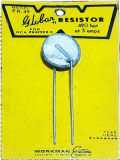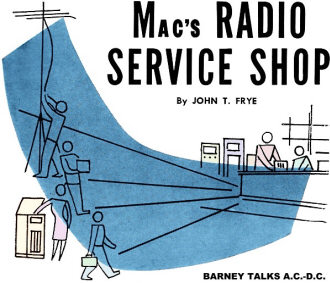Mac's Radio Service Shop: Barney Talks A.C.-D.C.
|
||
Mac's Radio Service Shop: Barney Talks A.C.-D.C. By John T. Frye
"Oh, Mr. Gallagher," Mac called, "as soon as all of the pretty little high school girls have passed on their way to school, would it be too much to ask you to come back here and help me get out a batch of these a.c.-d.c. sets?" Barney heaved a big sigh as he reluctantly turned away from the window. "Only a man without the least shred of poetry in his soul could say a thing like that," he muttered bitterly. "To ask me to turn my thoughts away from - well, from what I was thinking about - to a consideration of a.c.-d.c. receivers is to suggest a transition from the sublime to the ridiculous." "Spoken like a veteran service technician!" Mac applauded. "Cussing the a.c.-d.c. sets is the badge of the radio man who has really 'arrived.' It serves the same purpose as the complaint of the kid who has just returned from his first year away at college to the effect that the old home town is dead and ought to be buried. Sort of shows you are sophisticated, you know." Barney looked sharply at his employer. "You trying to pull my leg?" he demanded suspiciously. "Perish the thought!" Mac said blandly. "Do you like a.c.-d.c. sets?" Barney wanted to know. "Well, I like to eat; and so-called a.c.-d.c. receivers furnish me with a very sizable portion of my bread and butter." "Why do you say 'so-called' a.c.-d.c. sets ?" "It was a poor choice of words. They will work on either 110 volts of alternating or direct current; but not many of them have an opportunity to function on d.c. The main idea in the original design of the circuit was to get rid of the power transformer and so reduce the bulk, weight, and cost, all in one fell swoop. It happens, though, that subtracting parts is not good sales psychology. The salesman likes to be able to tell the customer about the 'extra' features that have been added. That is why, instead of saying 'This receiver has no transformer,' he says, 'Now here is a receiver that will work on either alternating or direct current:'" "Of course," Mac mused, "here in the United States, the likelihood that the ordinary individual would ever have occasion to plug his set into a 110 volt d.c. main is about as remote as that of his using his electric razor to take the fuzz off peaches; but the fact remains that it could be done." "I notice that the sets we get in that use 25Z5's, etc., seem to have less tube trouble than the ones using either the 35Z5 or the 35W4 strings. Why is that? Can't we make tubes as good now as we used to make them?" "I'm glad you noticed that," Mac said. "It is encouraging to know there are rare occasions when an object does not have to be edible or wear skirts to attract your attention. In the first place, you must know that it is the heavy first surge of current that flows through a cold filament that does the most damage. When the filament is cold, its resistance is only a fraction of what it is when the tube is at it proper operating temperature. The heavy current that flows when the set is first turned on and the magnetic fields accompanying such currents cause the loops of the filament to writhe inside the cathode sleeve and produce fractures of the filament wire." "Yeah, but the 25Z5 draws 300 mils of filament current, while the 35Z5 and the 35W4 only take 150 mils," Barney pointed out. "It looks like the 25Z5 filament would be the one doing the most wriggling." "Quite true, but remember the heavy-current type always uses a resistor in series with the filament string to make up for the difference between the total tube voltages and the line voltage. Sometimes this resistor is in the line cord; sometimes it is in the form of a ballast tube inside the set; but it always serves to remove the shock of that first current surge from the tubes. When the set is first turned on, most of the voltage appears across this resistor; then, as the tube filaments gradually warm up and increase their resistance, the voltage division gradually shifts to the proper proportion between the line resistor and the filament string." "Which is better: the line cord resistor or the ballast tube?" "Each has its advantages. The line cord resistor serves to put the heat dissipated by the voltage dropping resistor outside the cabinet, and this increases the life of the filter condensers and other units adversely affected by heat. On the other hand, the line cord will not take too much abuse without the resistance element breaking. What is more, we always have the amateur 'fixer' who decides he does not need all of that long line cord on his receiver and proceeds to cut off two or three feet of it; and then he wonders why his tubes burn out so quickly. While the ballast tube releases all of its heat inside the cabinet, it is usually a better deal if the set is to be carried about much or plugged in and out quite often." "Would you say the fact that no series resistor is used with the 150 mil type of tube accounts for their shorter life?" "Not altogether. These tubes are an improvement over the former types in the particular respect that they have more efficient filaments. Since they draw only half as much current, and since the wattage consumption is equal to the product of the voltage and the current, a string of 150-mil tubes will twirl the watt-hour-meter only half as fast as a 300-mil string. On the other hand, the filaments of such tubes are smaller, or at least more fragile, and they are subject to filament failures more often than the older tubes. "But you are the fellow who is knocking the a.c.-d.c. receivers," Mac broke off. "What else is wrong with them outside of the fact that they help us sell a lot of tubes?" "Well, their filter condensers do not last very long, it seems to me." "That's true in a lot of cases," Mac agreed, "but you can usually spot the reason. Quite often it is poor design. The filter condenser will be jammed up against a hot resistor, rectifier, or output tube, and the moisture will be literally baked out of it because the temperature rating of the condenser manufacturer is greatly exceeded. Another "common fault is to mount a filter condenser in a spring clip with too-tight jaws. As the wax of the condenser container is softened by heat, these spring jaws sometimes pinch the condenser nearly in half, causing various kinds of damage to the foil, oxide coating, and connecting tabs." "What's the cure?" "Always mount a replacement condenser in as cool a spot as you can find. This usually means at the bottom of the receiver chassis and as far away from the heat-radiating elements as possible. Make sure the condenser is mounted securely in place, but also make sure that it is not gripped by any clamp that will distort its form. See that the set has all of the ventilation you can give it without actually baring any portions of the 'hot' chassis to possible contact with the owner's hands." "Well," Barney thoughtfully conceded, "when everything is taken into account, perhaps the a.c.-d.c. set does a pretty good job after all. Such sets are comparatively cheap to purchase, and most of them see lots of action without receiving too gentle usage. I suppose, though, that they are on their way out now that television is here." "Never think it!" Mac said as he picked up a service sheet he had been reading. "Here is some dope on a new TV receiver using an improved voltage-doubling, transformerless type of power supply with the receiver tube filaments connected in series strings. The voltage-doubling circuit yields all of the "B" voltage needed, and a new type of resistor, called the "Globar," is used in series with each string of filaments to remove the curse of the high initial surge of current. "A globar resistor has a negative resistance characteristic that is just the opposite of that of a tube filament. Its resistance is highest when it is cold. As it warms up, its resistance will decrease to less than one-fifth of its cold value. That means that the current through the filaments of a string of tubes in series with such a resistor will remain practically constant during the complete warm-up cycle. Such a system is actually easier on the filaments than heating them with a transformer." After a little pause, Mac summed up what he had been thinking: "I think the root of the whole matter is that the a.c.-d.c. circuit was first employed in an attempt to make a cheap receiver, and gradually the term 'a.c.-d.c.' came to be used as a synonym for cheap construction and pinch-penny engineering. This really does an injustice to the transformerless type of circuit, because with modern tubes, selenium rectifiers, Globar resistors, etc., you can do just about anything with this type of circuit that you can do with one employing a transformer, and you can usually do it on a smaller chassis, with less weight, and at a lower cost. Communication receiver engineers have proved that. Furthermore-" "Say no more!" Barney interrupted with an upraised hand. "Let the defense rest. Its case is won. From now on, I would no more think of saying anything against an a.c.-d.c. set than I would of criticizing Margie's appearance in a sun suit; and that is just as near perfection as you will find anywhere!"
Posted June 14, 2023 Mac's Radio Service Shop Episodes on RF Cafe This series of instructive technodrama™ stories was the brainchild of none other than John T. Frye, creator of the Carl and Jerry series that ran in Popular Electronics for many years. "Mac's Radio Service Shop" began life in April 1948 in Radio News magazine (which later became Radio & Television News, then Electronics World), and changed its name to simply "Mac's Service Shop" until the final episode was published in a 1977 Popular Electronics magazine. "Mac" is electronics repair shop owner Mac McGregor, and Barney Jameson his his eager, if not somewhat naive, technician assistant. "Lessons" are taught in story format with dialogs between Mac and Barney.
|
||


